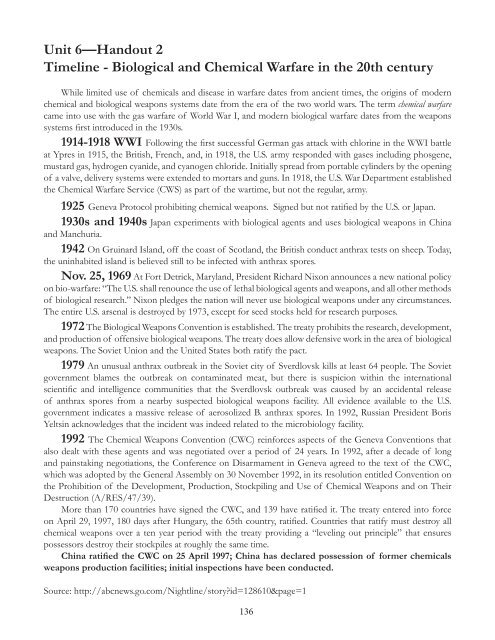Download - Canada ALPHA
Download - Canada ALPHA
Download - Canada ALPHA
Create successful ePaper yourself
Turn your PDF publications into a flip-book with our unique Google optimized e-Paper software.
Unit 6—Handout 2<br />
Timeline - Biological and Chemical Warfare in the 20th century<br />
While limited use of chemicals and disease in warfare dates from ancient times, the origins of modern<br />
chemical and biological weapons systems date from the era of the two world wars. The term chemical warfare<br />
came into use with the gas warfare of World War I, and modern biological warfare dates from the weapons<br />
systems fi rst introduced in the 1930s.<br />
1914-1918 WWI Following the fi rst successful German gas attack with chlorine in the WWI battle<br />
at Ypres in 1915, the British, French, and, in 1918, the U.S. army responded with gases including phosgene,<br />
mustard gas, hydrogen cyanide, and cyanogen chloride. Initially spread from portable cylinders by the opening<br />
of a valve, delivery systems were extended to mortars and guns. In 1918, the U.S. War Department established<br />
the Chemical Warfare Service (CWS) as part of the wartime, but not the regular, army.<br />
1925 Geneva Protocol prohibiting chemical weapons. Signed but not ratifi ed by the U.S. or Japan.<br />
1930s and 1940s Japan experiments with biological agents and uses biological weapons in China<br />
and Manchuria.<br />
1942 On Gruinard Island, off the coast of Scotland, the British conduct anthrax tests on sheep. Today,<br />
the uninhabited island is believed still to be infected with anthrax spores.<br />
Nov. 25, 1969 At Fort Detrick, Maryland, President Richard Nixon announces a new national policy<br />
on bio-warfare: “The U.S. shall renounce the use of lethal biological agents and weapons, and all other methods<br />
of biological research.” Nixon pledges the nation will never use biological weapons under any circumstances.<br />
The entire U.S. arsenal is destroyed by 1973, except for seed stocks held for research purposes.<br />
1972 The Biological Weapons Convention is established. The treaty prohibits the research, development,<br />
and production of offensive biological weapons. The treaty does allow defensive work in the area of biological<br />
weapons. The Soviet Union and the United States both ratify the pact.<br />
1979 An unusual anthrax outbreak in the Soviet city of Sverdlovsk kills at least 64 people. The Soviet<br />
government blames the outbreak on contaminated meat, but there is suspicion within the international<br />
scientifi c and intelligence communities that the Sverdlovsk outbreak was caused by an accidental release<br />
of anthrax spores from a nearby suspected biological weapons facility. All evidence available to the U.S.<br />
government indicates a massive release of aerosolized B. anthrax spores. In 1992, Russian President Boris<br />
Yeltsin acknowledges that the incident was indeed related to the microbiology facility.<br />
1992 The Chemical Weapons Convention (CWC) reinforces aspects of the Geneva Conventions that<br />
also dealt with these agents and was negotiated over a period of 24 years. In 1992, after a decade of long<br />
and painstaking negotiations, the Conference on Disarmament in Geneva agreed to the text of the CWC,<br />
which was adopted by the General Assembly on 30 November 1992, in its resolution entitled Convention on<br />
the Prohibition of the Development, Production, Stockpiling and Use of Chemical Weapons and on Their<br />
Destruction (A/RES/47/39).<br />
More than 170 countries have signed the CWC, and 139 have ratifi ed it. The treaty entered into force<br />
on April 29, 1997, 180 days after Hungary, the 65th country, ratifi ed. Countries that ratify must destroy all<br />
chemical weapons over a ten year period with the treaty providing a “leveling out principle” that ensures<br />
possessors destroy their stockpiles at roughly the same time.<br />
China ratifi ed the CWC on 25 April 1997; China has declared possession of former chemicals<br />
weapons production facilities; initial inspections have been conducted.<br />
Source: http://abcnews.go.com/Nightline/story?id=128610&page=1<br />
136


